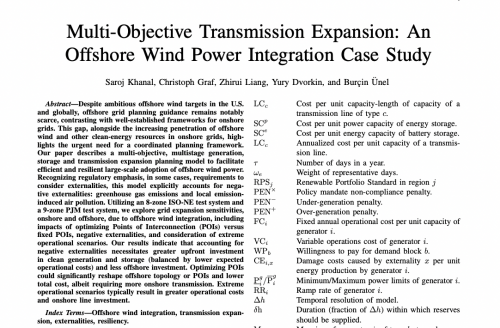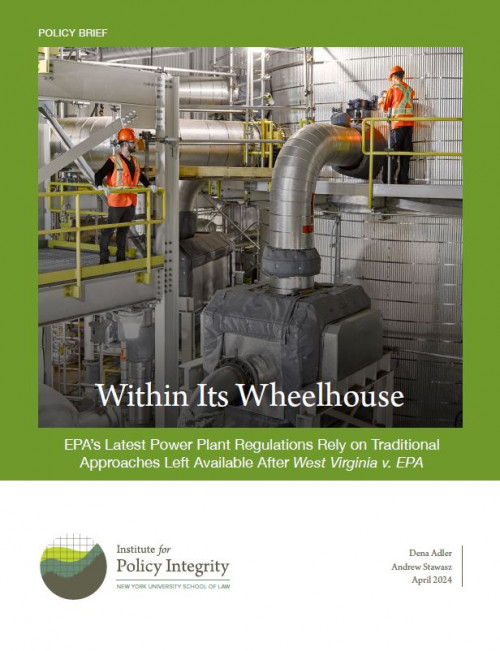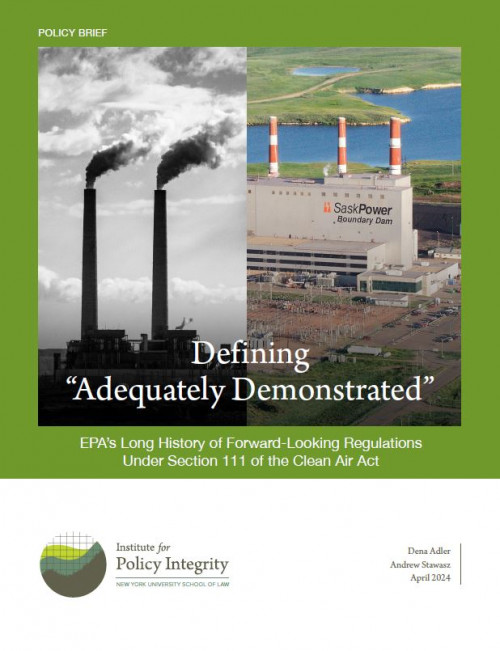-
Comments to DOT on Accessibility Rule for Air Travelers with Disabilities Using Wheelchairs
In March 2024, the Department of Transportation (DOT) proposed a multifaceted regulation that would facilitate greater access to air transportation for passengers with disabilities, particularly those who depend on wheelchairs and other assistive devices. Policy Integrity submitted comments to the agency arguing that, while DOT persuasively shows that the Proposed Rule carries many important benefits, the agency should improve upon its proposal and the accompanying benefit-cost analysis in several ways
-
Regulatory Antecedents and the Major Questions Doctrine
Published in the Georgetown Environmental Law Review
In recent years, federal courts have increasingly assessed the legality of regulatory action by considering its antecedents, or lack thereof, in prior agency actions. Yet as this article explains, federal agencies have insufficiently adapted to this increased judicial focus on regulatory antecedents. While significant agency rulemakings typically include extensive dockets with many different types of analysis, they have generally provided limited analysis of regulatory antecedents. This article suggests that agencies more extensively catalog regulatory antecedents at all stages of the rulemaking process, from drafting to promulgation.
-
Policy Integrity Scholarship and Advocacy Reflected in CEQ’s Rule for Conducting Environmental Review
On April 30, CEQ revised its implementing regulations for the National Environmental Policy Act that undergird how federal agencies conduct environmental review of proposed projects. Consistent with federal caselaw, CEQ’s regulations emphasize the need to consider climate change and environmental justice impacts in environmental review, among other key revisions. These revisions are also consistent with suggestions that Policy Integrity has offered through our scholarship, reports, and comments on ensuring careful consideration of climate change and environmental justice in federal permitting. In addition, CEQ implemented several of Policy Integrity’s suggestions to enhance its cost-benefit analysis for this rulemaking.
-
Policy Integrity Recommendations Reflected in DOE’s Transmission Permitting Rule
On April 25, 2024, the Department of Energy (DOE) released its final rule under 16 U.S.C. § 824p(h) to expedite the federal authorization of transmission projects. We commented in support of the proposal, including DOE's proposed requirement that project proponents describe how the transmission project would affect power-system greenhouse gas (GHG) emissions. In the final rule, DOE retained the requirement to describe power-system GHG impacts and, in response to our recommendation, clarified that the ambiguous language in the proposal does require project proponents to estimate non-power-system GHG emissions and power-system emissions of local air pollutants.
-
Policy Integrity Suggestions Reflected in DOT’s Final Rule Requiring Automatic Refunds of Airline Tickets
On April 24, 2024, DOT issued a final rule on airline ticket refunds which, among other things, will require airlines to offer refunds when a passenger’s itinerary is significantly changed or delayed, and will require that passengers be given a ticket voucher if a serious communicative disease prevents them from flying. We submitted comments to DOT in November 2022 explaining that, in our view, DOT’s benefit-cost analysis was underestimating the benefits of these policies. DOT’s finalized analysis discusses our comments extensively, and implements many of our suggestions.
-
Within Its Wheelhouse
EPA’s Latest Power Plant Regulations Rely on Traditional Approaches Left Available After West Virginia v. EPA
In May 2023, EPA proposed new limits for greenhouse gas (GHG) emissions from certain fossil-fuel-fired power plants under Section 111 of the Clean Air Act. Some critics have suggested that EPA’s new rule triggers the major questions doctrine. Under that doctrine, a court should look skeptically on the agency action in extraordinary cases involving unprecedented and transformative applications of agency authority. But the major questions doctrine is inapplicable to EPA’s use of CCS in its proposed regulations. Rather than propose a new approach that would transform its exercise of statutory authority, EPA has embraced one of its most traditional and well-established regulatory practices: setting emission limits based on pollution controls that cause a regulated source to operate more cleanly. This policy brief details why EPA’s latest proposal to limit GHG emissions from power plants fits neatly within the bounds of the legal authority left intact after West Virginia. It then explains how states and operators retain flexibility to use emission trading and averaging programs to implement EPA’s regulations.
-
Defining “Adequately Demonstrated”
EPA’s Long History of Forward-Looking Standards Under Section 111 of the Clean Air Act
In May 2023, the Environmental Protection Agency (EPA) proposed new limits for greenhouse gas (GHG) emissions from certain fossil-fuel-fired power plants under Section 111 of the Clean Air Act. Section 111 requires EPA to set limits reflecting the emission reductions achievable by applying what the agency determines to be the “best system of emission reduction” (BSER) that “has been adequately demonstrated,” and that meets certain other statutory factors. This policy brief summarizes the legal framework of Section 111 (including the legislative history and caselaw relevant to understanding its technology-forcing nature), walks through how courts have interpreted “adequately demonstrated,” reviews EPA’s past use of Section 111 to drive technology improvements, and explains why a potential Supreme Court decision that eliminates or curtails Chevron deference (a legal doctrine providing deference to reasonable agency interpretations of ambiguous statutory language) would not affect the longstanding interpretation of “adequately demonstrated.”
-

Multi-Objective Transmission Expansion
An Offshore Wind Power Integration Case Study
Our paper describes a multi-objective, multistage generation, storage and transmission expansion planning model to facilitate efficient and resilient large-scale adoption of offshore wind power. Recognizing regulatory emphasis and, in some cases, requirements to consider externalities, this model explicitly accounts for negative externalities: greenhouse gas emissions and local emission-induced air pollution. Our results indicate that accounting for negative externalities necessitates greater upfront investment in clean generation and storage (balanced by lower expected operational costs). Optimizing POIs could significantly reshape offshore topology or POIs, and lower total cost. Finally, accounting for extreme operational scenarios typically results in greater operational costs and sometimes may alter onshore line investment.
-
Comments to the Army Corps of Engineers on Agency Specific Procedures to Implement the Principles, Requirements, and Guidelines for Water Resources Investments
In February 2024, the Army Corps of Engineers proposed a series of procedures to implement the governmentwide Principles, Requirements, and Guidelines for water-resource projects. The “heart” of these agency-specific procedures (ASPs) is ensuring that decisionmakers consider a wide suite of economic, environmental, and social benefits and costs as they invest in such projects. The proposal reasonably moves the Corps away from its historical and inefficiently narrow focus on national economic development to the exclusion of other essential objectives like environmental quality and distributional considerations. While the proposal takes valuable steps toward more comprehensive accounting of societal benefits and improved decisionmaking, our comments recommended several reasonable steps the Corps can take to make these ASPs even more effective.
-
Comments to Montana PSC on Petition for Rulemaking on Consideration of Climate Impacts
In February, a coalition of public-interest organizations filed a petition for rulemaking requesting that the Montana Public Service Commission consider climate change in its regulation of electric and gas utilities. The Petition for Rulemaking calls on the Commission to consider the impacts of climate change in its proceedings using the Environmental Protection Agency’s latest estimates of the social cost of greenhouse gases. In support of the petition, we submitted comments offering a few helpful insights.






